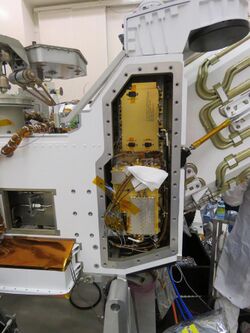Engineering:RIMFAX
 RIMFAX radar imager | |
| Operator | NASA |
|---|---|
| Manufacturer | Norwegian Defence Research Establishment |
| Instrument type | Ground-penetrating radar |
| Function | Study subsurface structure |
| Properties | |
| Mass | 3 kg (6.6 lb) |
| Dimensions | 19.6 × 12.0 × 0.66 cm |
| Power consumption | Max: 10 watts |
| Resolution | 15 cm to 30 cm (3" to 12") |
| Host spacecraft | |
| Spacecraft | Perseverance |
| Operator | NASA |
| Launch date | 30 July 2020, 11:50:00 UTC |
| Rocket | Atlas V |
| Launch site | Cape Canaveral, SLC-41 |
| COSPAR ID | 2020-052A |
The Radar Imager for Mars' subsurface experiment (RIMFAX) is a ground-penetrating radar on NASA's Perseverance rover, part of the Mars 2020 mission. It uses radar waves to see geologic features under the surface.
The device can make detections perhaps dozens of meters/yards underneath ground, such as for buried sand dunes or lava feature.[1] During development a detection range of about 10 yards/meters was targeted, and tests on glaciers were successful.[2]
RIMFAX takes its name from Hrímfaxi, the horse in Norse mythology that "faithfully brings the night."[3]
The radar will operate at radio frequencies of 150–1200 MHz and will use a Bow-Tie Slot antenna.[2]
Overview
RIMFAX is a ground-penetrating radar, its antenna is located on the lower rear of the Perseverance rover. It will be able to image different ground densities, structural layers, buried rocks, meteorites, and detect underground water ice and salty brine at 10 m (33 ft) depth.
Ground-penetrating radars (GPR) send radio frequency electromagnetic waves into the ground and then detect the reflected signals as a function of time to reveal subsurface structure as well as composition. RIMFAX is based on a number of GPR instruments developed at the Norwegian Defence Research Establishment (FFI).[4] RIMFAX was selected by NASA to be one of the instruments on the Mars 2020 rover in July 2014. RIMFAX will provide the science team with the capability to assess the shallow layers and their stratigraphic relationship to nearby outcrops, and thus a window into the geological history and associated environmental history.[4]
The RIMFAX instrument was developed and built by FFI, and it was delivered to NASA's Jet Propulsion Laboratory for integration with the rover in December 2018. Due to Mars's 24.5 hour long day, RIMFAX operations are shared between centers at University of California, Los Angeles (UCLA) and the University of Oslo (UiO), swapping every two weeks.[5] The RIMFAX data will be archived by NASA's Planetary Data System.[6] The RIMFAX principal investigator is Svein-Erik Hamran of FFI, and his team includes scientists from Norway , Canada and the United States .[7]
Specifications
RIMFAX employs a gated Frequency Modulated Continuous Wave (FMCW) waveform to probe the subsurface. Gated FMCW utilizes a single antenna for both transmission and reception, quickly switching the antenna between the transmitter and the receiver. RIMFAX will be commanded to acquire radar soundings every 10–20 cm along the rover's path to create two-dimensional GPR images of subsurface structure.
| Specifications | Units/performance[3][4] |
|---|---|
| Mass | 3 kg (6.6 lb) |
| Power | 5 to 10 watts |
| Dimensions | 19.6 × 12.0 × 0.66 cm (7.0" × 4.7" × 2.4") |
| Data return | 5 to 10 kbytes per sounding location |
| Frequency range | 150 to 1200 MHz |
| Vertical resolution | 15 cm to 30 cm (6" to 12") |
| Penetration depth | ≤10 m (33 ft) |
| Measurement interval |
Every 10 cm (3.9 in) |
Development
An engineering model of RIMFAX was tested in several locations, primarily in Svalbard, and in the US Southwest. Modelling was carried out with gprMax, an open source electromagnetic simulation tool, to assess the imaging potential at the landing site.[8][9]
Contemporaries
Other Mars radar experiments include SHARAD, MARSIS, and WISDOM.[10]
See also
External links
- NASA project homepage
- FFI project homepage
- RIMFAX data on the Planetary Data System
- gprMAX Electromagnetic simulation software
References
- ↑ "Next Mars rover will use 'X-ray vision' to spot buried treasure". CBC News. http://www.cbc.ca/news/technology/mars-2020-rover-s-rimfax-radar-will-see-deep-underground-1.2739698.
- ↑ Jump up to: 2.0 2.1 Hamran, S. E.; Berger, T.; Brovoll, S.; Damsgård, L.; Helleren, Ø.; Øyan, M. J.; Amundsen, H. E.; Carter, L. et al. (July 2015). "RIMFAX: A GPR for the Mars 2020 rover mission". 2015 8th International Workshop on Advanced Ground Penetrating Radar (IWAGPR). pp. 1–4. doi:10.1109/IWAGPR.2015.7292690. ISBN 978-1-4799-6495-6.
- ↑ Jump up to: 3.0 3.1 "Mars 2020 Rover - RIMFAX". NASA. 2017. https://mars.nasa.gov/mars2020/mission/instruments/rimfax/.
 This article incorporates text from this source, which is in the public domain.
This article incorporates text from this source, which is in the public domain.
- ↑ Jump up to: 4.0 4.1 4.2 "RIMFAX - ground penetrating radar". Norwegian Defence Research Establishment. 2015-08-14. https://www.ffi.no/en/news/rimfax-ground-penetrating-radar.
- ↑ Paige, David (February 18, 2021). "Q&A: David Paige on the Feb. 18 Mars Perseverance landing" (Interview). Interviewed by Stuart Wolpert.
Since the rover will be working on Mars time, in which the days are 24.5 hours long, responsibility for the operation of RIMFAX will pingpong between Norway and UCLA every two weeks.
- ↑ "PDS Data Release Calendar 2021". https://pds.nasa.gov/datasearch/subscription-service/data-release-calendar.shtml. "Anticipated Release Date - 08/20/2021"
"Mars 2020 Mission Perseverance Rover". https://pds-geosciences.wustl.edu/missions/mars2020/index.htm. "The first release of PDS data will be on August 20, 2021." - ↑ "RIMFAX science team". 19 September 2014. http://www.ffi.no/en/research-projects/rimfax/Sider/Team.aspx.
- ↑ , Wikidata Q105715907
- ↑ , Wikidata Q64455906
- ↑ , Wikidata Q105725095
 |



